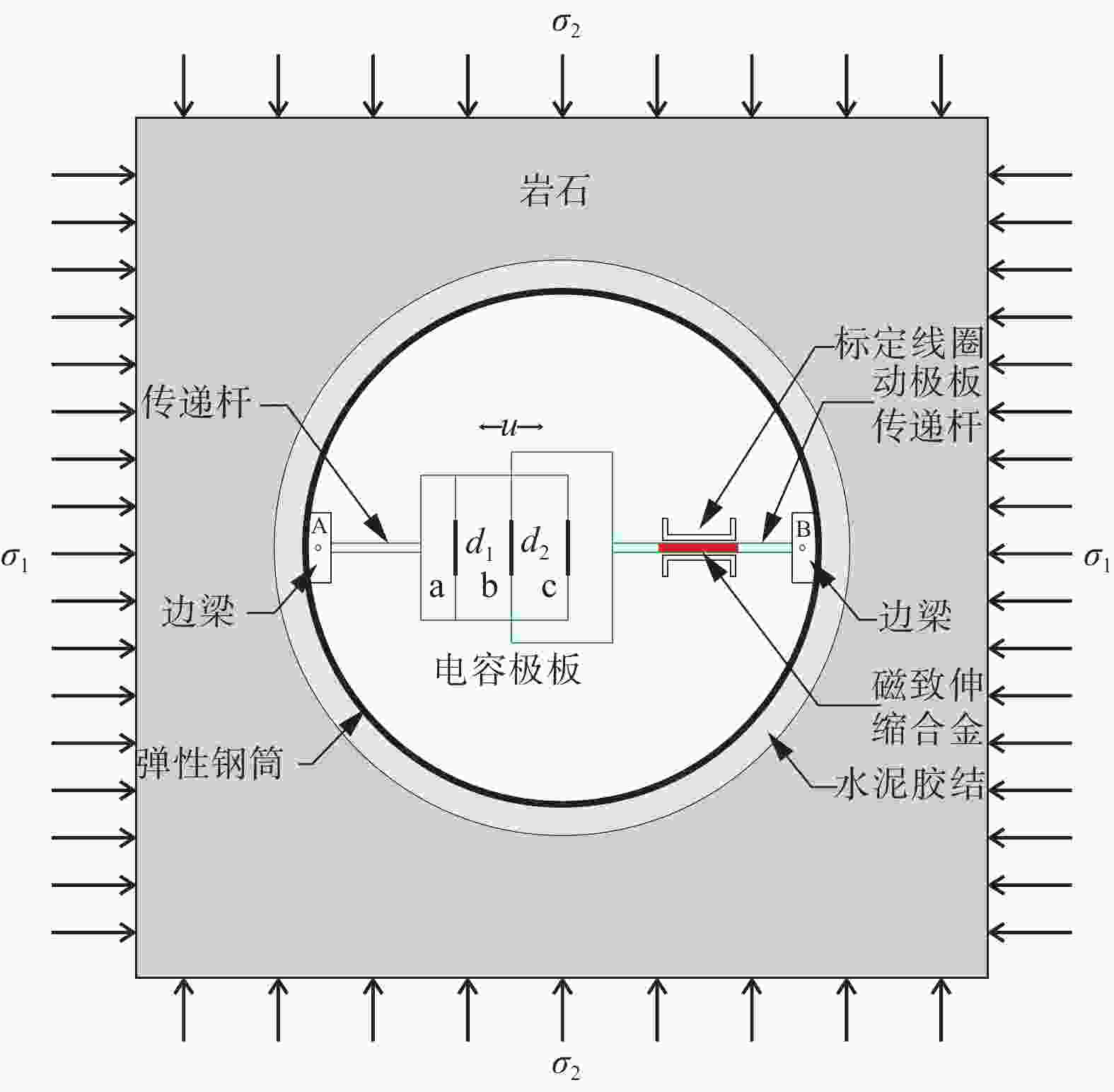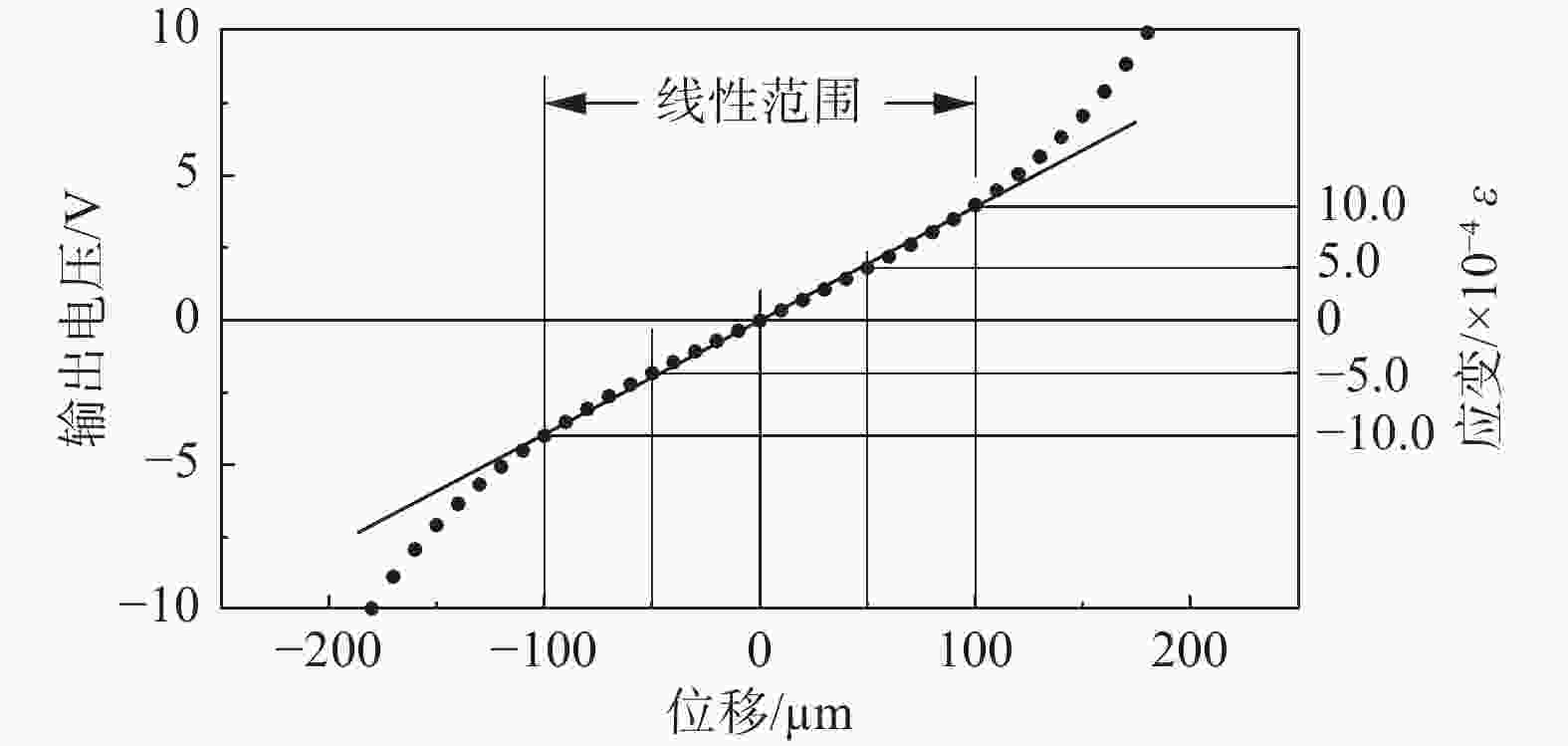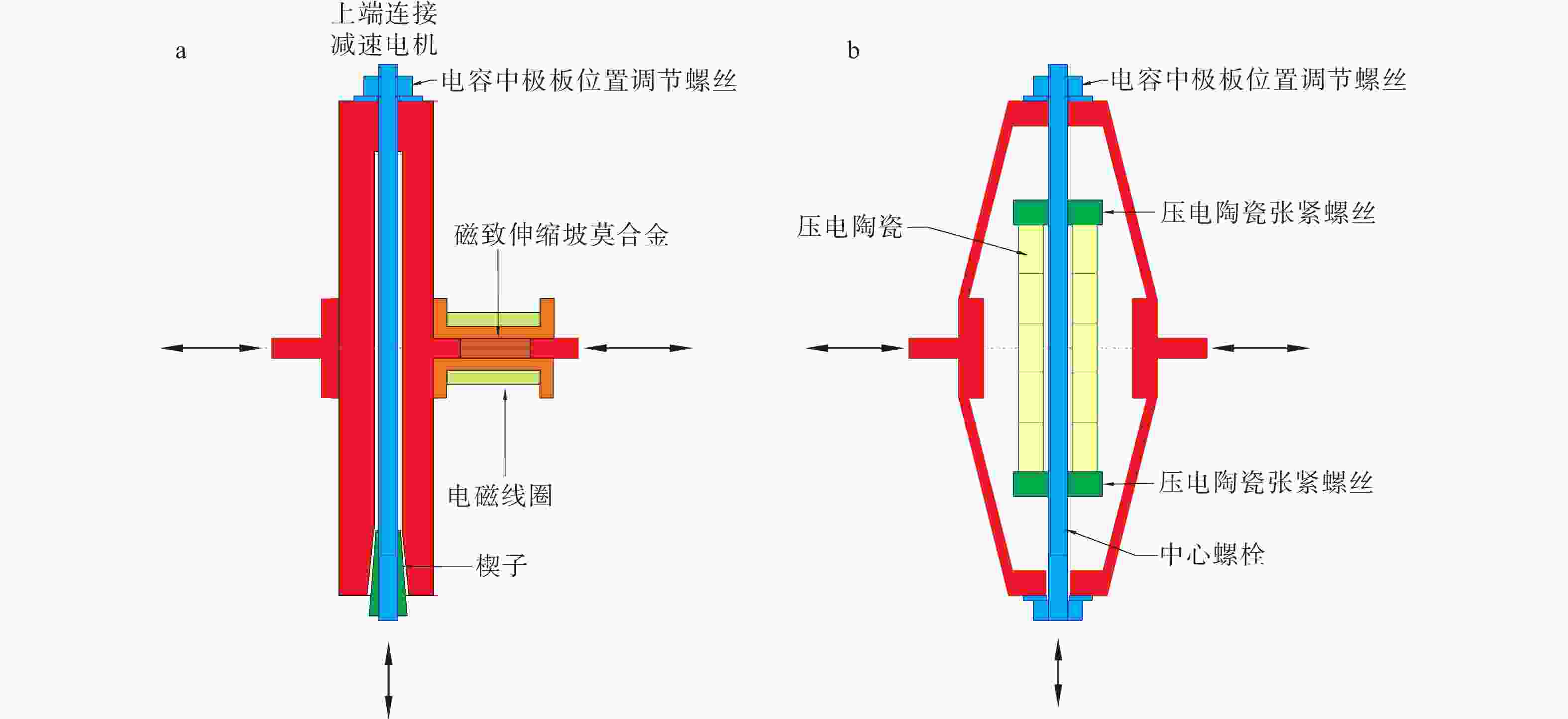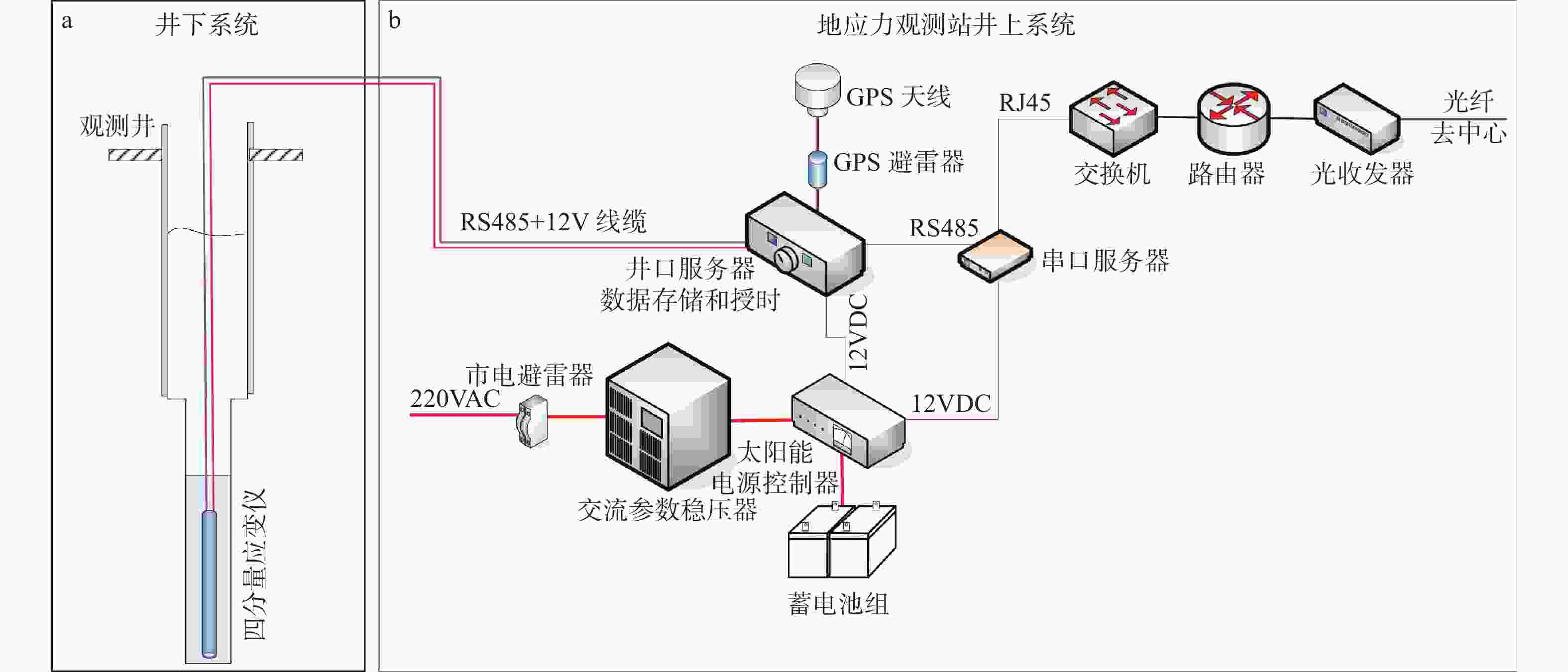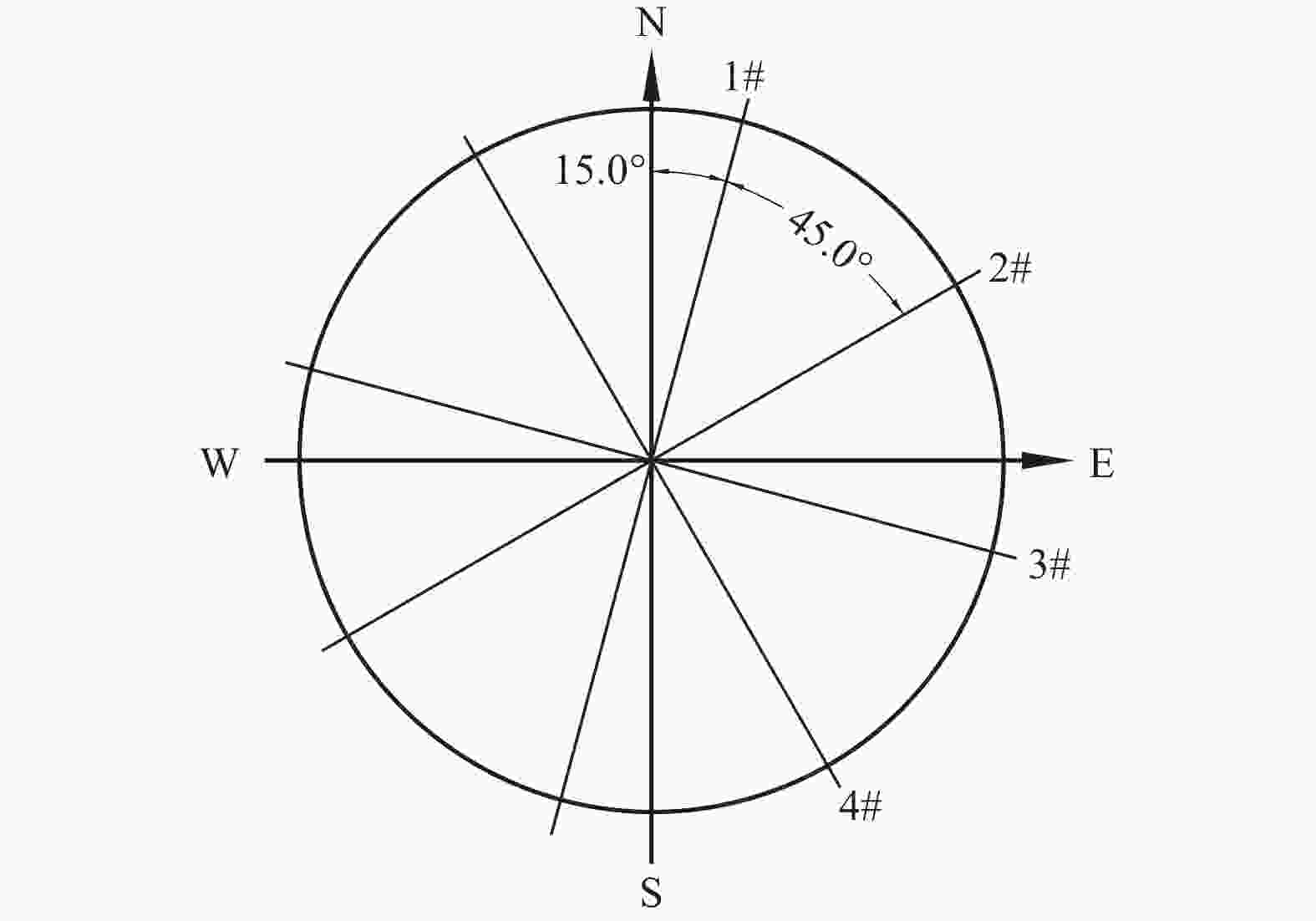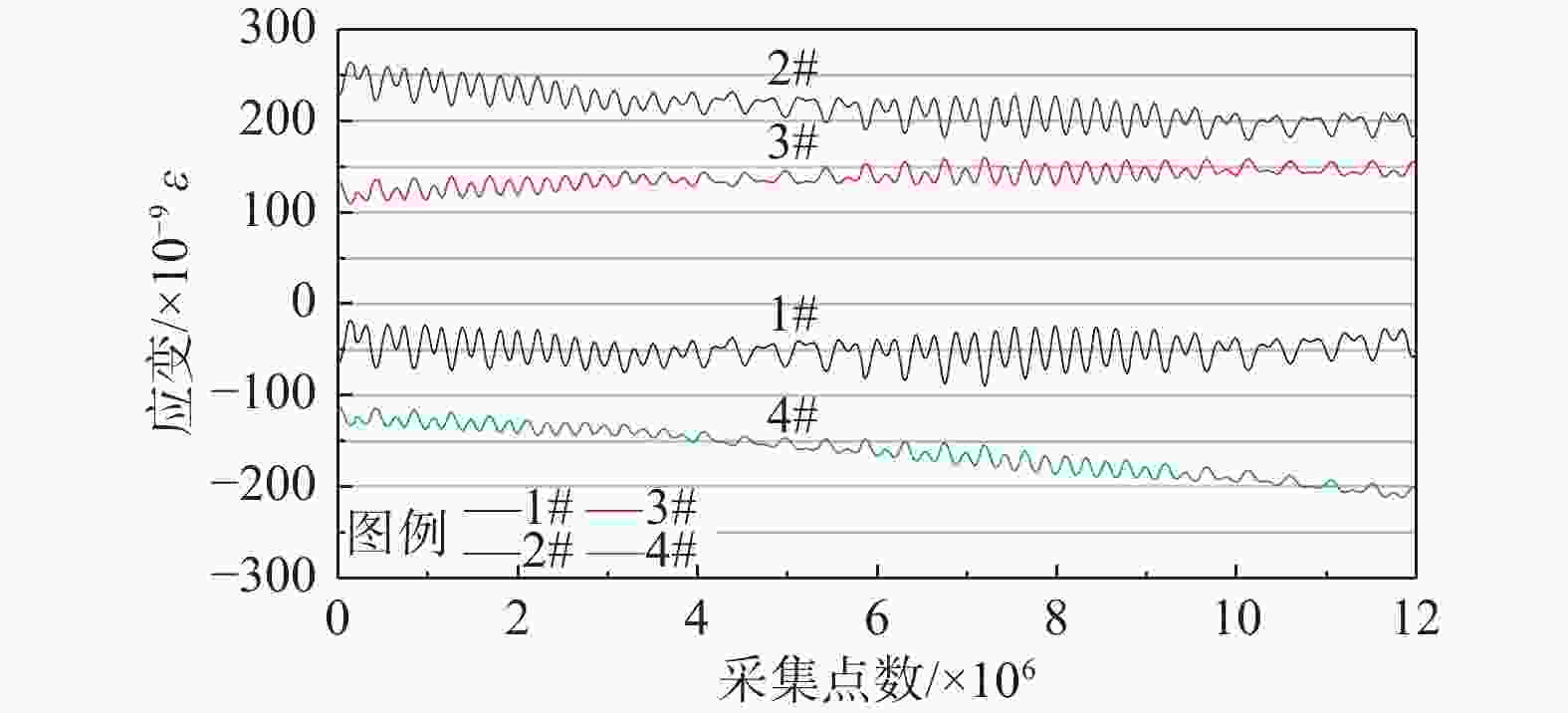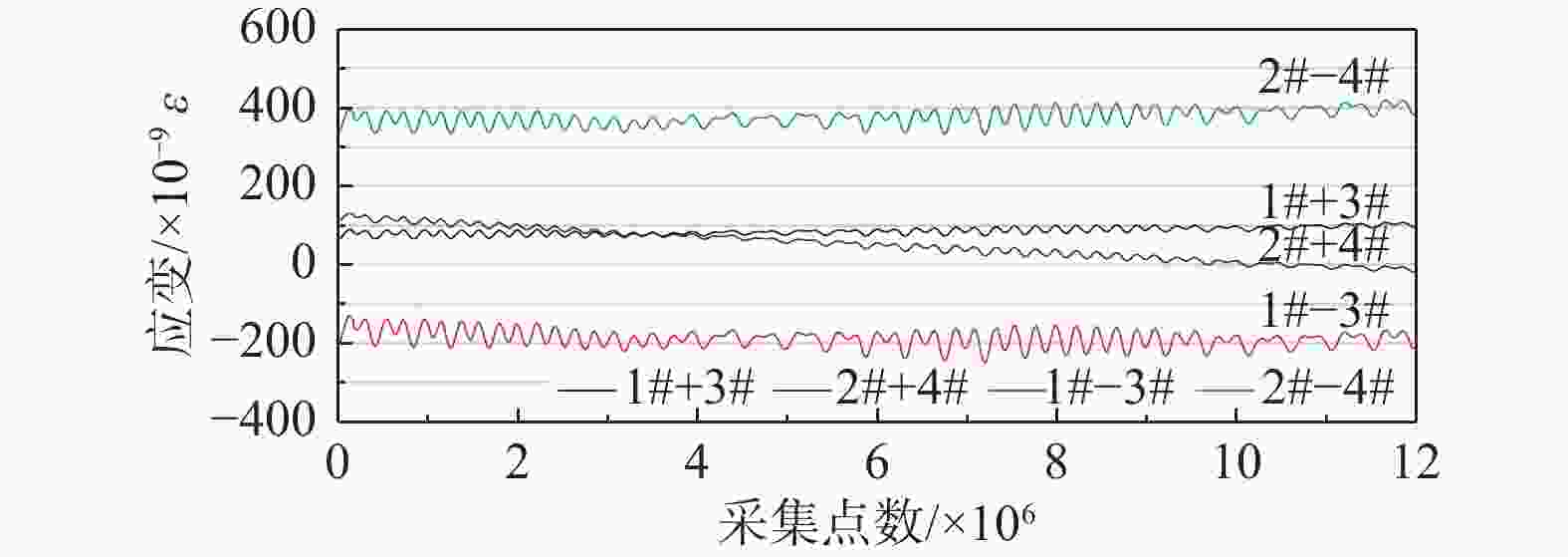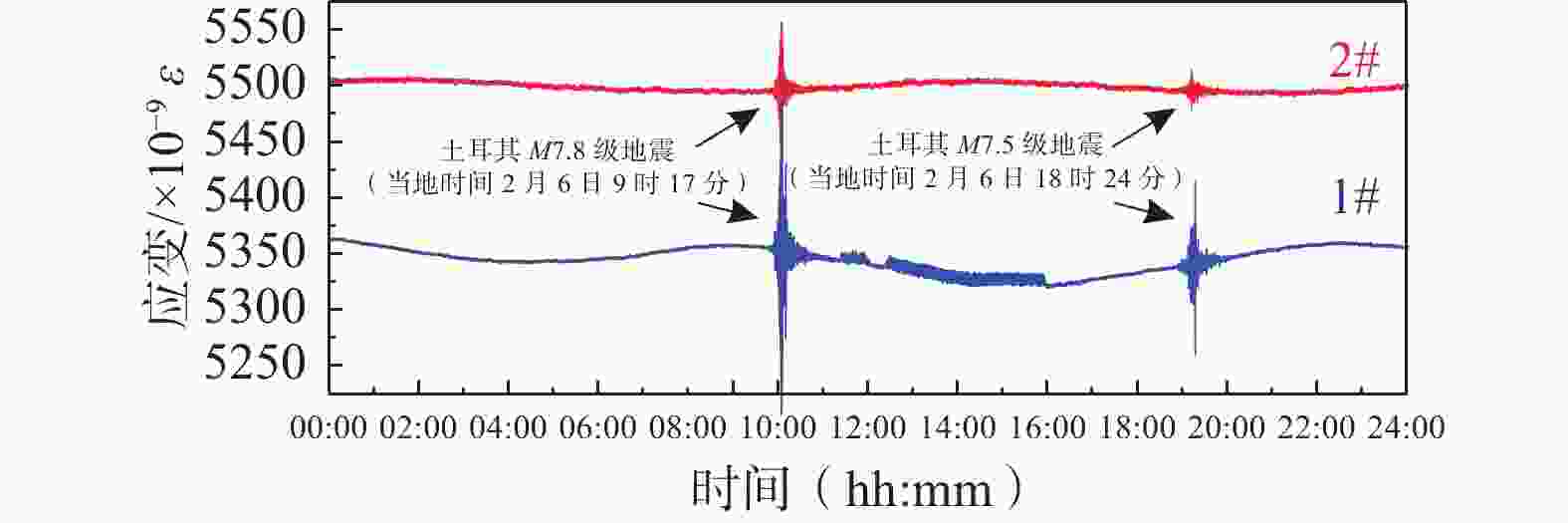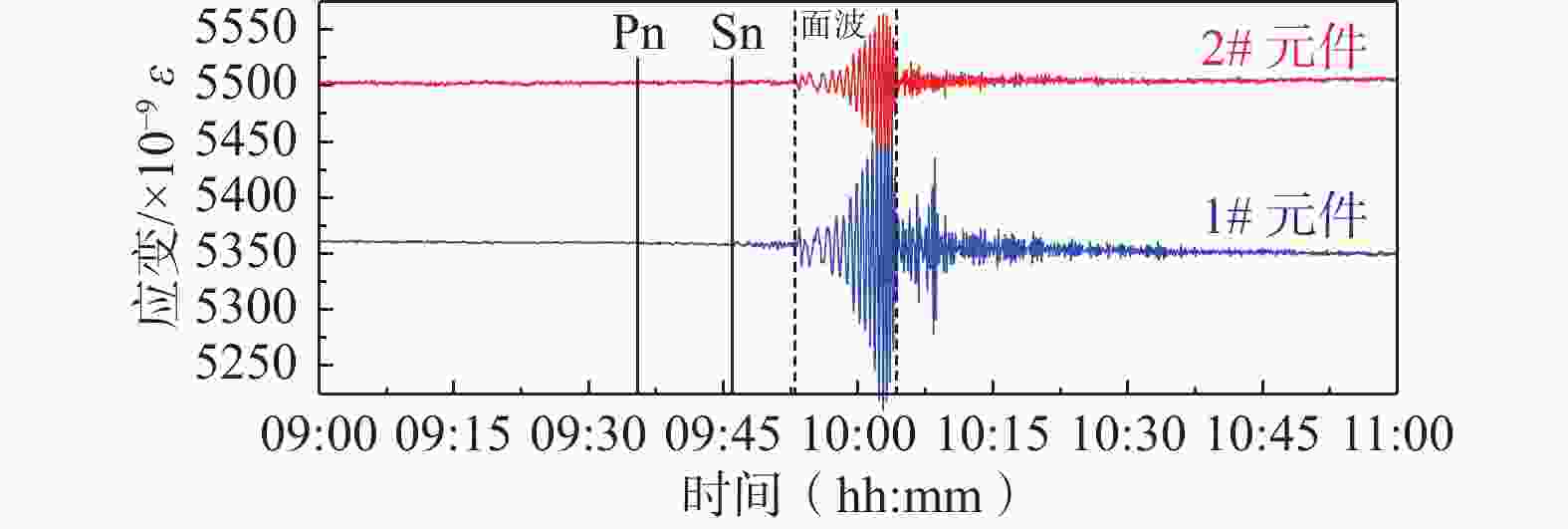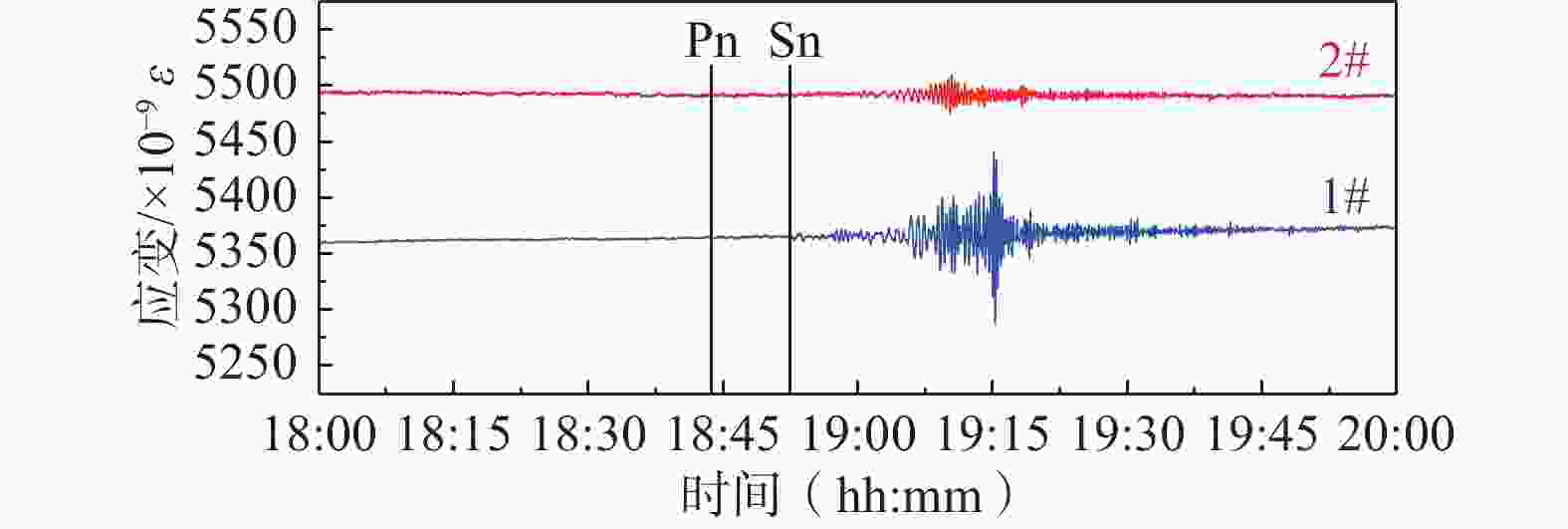Key technology and application of DRY-1B capacitive component borehole strain gauge
-
摘要:
文章简述了DRY-1B型电容分量式钻孔应变仪(简称“钻孔应变仪”)的理论基础,攻关了微位移感知、降噪、控温、性能测试、标定等关键技术,并通过了性能测试,标定结果表明:该应变仪达到了高分辨率(≥5×10−11ε)、宽频带(10~100 Hz可选)、大动态范围(≥1×10−3ε)、24位AD记录、低功耗(<3 W)等技术指标,其性能优于同期美国PBO和日本同类钻孔应变仪,是一款国际领先的地壳运动长期观测仪器,基本能够满足地壳长期应变缓慢积累的蠕变运动和短期应变快速变化的地震火山活动等观测需求。2008年以来,通过20余个地应力台站的应用,该钻孔应变仪记录到大量的地壳形变、断裂活动、同震应变波、应变阶跃、矿压活动等应变信息,并以北长山地应力台站应变监测数据自洽性检验和土耳其地震映震能力分析为例发现:北长山地应力台站电容传感器1#+3#和2#+4#元件应变曲线总体平稳,相关系数R2达到0.95;1#-3#和2#-4#元件的差应变年变化速率为10−8量级,反映出长岛地区以剪切应力为主,且处于地震活动相对高的应力环境;利用该应变仪观测到2023年2月6日土耳其M 7.8级和M 7.5级两次地震明显的同震应变响应,尤其是获取了M 7.8级主震面波周期为50~60 s,呈现出面波异常,理论上可分辨出100 km范围M 0.74级地震产生的应变波,达到了应用示范效果。该钻孔应变仪在地球动力学研究、内动力地质灾害监测等领域具有较好的推广价值和应用前景。
Abstract:This paper briefly describes the theoretical basis of the DRY-1B capacitive component drilling strain gauge (drilling strain gauge). It discusses critical technologies such as micro-displacement sensing, noise reduction, temperature control, performance testing, and calibration. The strain gauge achieved high resolution (≥5×10−11ε), wideband (10–100 Hz optional), extensive dynamic range (≥1×10−3ε), 24-bit AD recording, low power consumption (< 3W), and other technical indicators. Its performance is better than the United States PBO and Japan borehole strain gauge of the same period, and it is an international leading long-term observation instrument for crustal movement, which can basically meet the observation requirements of creep movement with slow accumulation of long-term strain and seismic and volcanic activity with a rapid change of short-term strain. Since 2008, through the application of more than 20 geostress stations, the borehole strain gauge has recorded a large amount of strain information, such as crustal deformation, fault activity, co-seismic strain wave, strain step, and ore pressure activity. Based on the results of the self-consistency test of strain monitoring data of the geostress station in the Beichangshan Mountain and the analysis of seismic mapping capacity of the Turkey earthquake, it is found that the strain curves of the 1#+3# and 2#+4# capacitance sensors at the Beichangshan Mountain stress station are generally stable, and the correlation coefficient R2 is 0.95. The annual variation rate of the differential strain of 1#–3# and 2#–4# elements is 10−8 magnitude, which reflects that the shear stress is dominant in the Long Island area and the stress environment of seismic activity is relatively high. The strain gauge was used to observe the apparent co-seismic strain response of Turkey’s M 7.8 and M 7.5 earthquakes on February 6, 2023. In particular, it obtained the M 7.8 main seismic surface wave period of 50–60 s, presenting an out-facing wave anomaly. Theoretically, the strain wave generated by the M 0.74 earthquakes within 100 km can be distinguished, and the application demonstration effect has been achieved. The borehole strain gauge has good popularization value and application prospects in geodynamics research and internal dynamic geological disaster monitoring.
-
图 1 钻孔应变仪探头结构与电容传感器原理图
σ1—最大水平主应力,MPa;θ—测量轴线与地理北的夹角,(°);φ—最大水平主应力与地理北的夹角,(°);d1、d2—极板间距,μm
Figure 1. Diagram showing the working principle of capacitance displacement sensor
σ1–maximum horizontal principal stress, MPa; θ–angle between measurement axis and geographic north, (°); φ–angle between maximum horizontal principal stress and geographic north, (°)
图 2 电容位移传感器结构示意图
σ1—最大水平主应力,MPa;σ2—最小水平主应力,MPa;u-钻孔孔径位移量(即极板的位移量),μm;a、b、c—极板编号;d1—极板a和极板b之间的距离,μm;d2—极板b和极板c之间的距离,μm
Figure 2. Schematic showing the structure of capacitance displacement sensor
σ1–maximum horizontal principal stress, MPa; σ2–minimum horizontal principal stress, MPa; u–displacement of the pole plate, μm; a, b and c–pole plate numbers; d1–distance between pole plate a and pole plate b, μm; d2–distance between pole plate b and pole plate c, μm
表 1 系统技术指标
Table 1. Technical specifications of the borehole strain monitoring system
技术指标 技术参数 技术指标 技术参数 供电电压 12~48 V DC 数据传输模式/波特率 RS485/9600BPS 井下功耗 总功耗<3 W 通道/角度 4分量/45°分布 AD位数 内置数据采集,24位 观测分辨率 ≥5×10−11ε 采样速率 所有分量10~100 Hz 观测动态范围 ≥1×10−3ε 注:电子罗盘、温度、孔隙压问答式查询返回数据 -
[1] BENIOFF H, PRESS F, SMITH S, 1961. Excitation of the free oscillations of the earth by earthquakes[J]. Journal of Geophysical Research, 66(2): 605-619. doi: 10.1029/JZ066i002p00605 [2] CHEN N, WANG C H, CHEN P Z, et al. , 2021. Reunderstanding of ground stress field characteristics of right bank of Baihetan using borehole caving data [J]. Journal of Geomechanics, 27(3): 430-440. (in Chinese with English abstract) [3] CHEN Y Q, ZHANG S L, LI H W, 2021. Analysis on characteristics of regional strain field based on four-component borehole strain[J]. Journal of Geodesy and Geodynamics, 41(10): 1095-1100. (in Chinese with English abstract) [4] CHI S L, 1977. Electric capacity stress meter of automatic continuous recording[M]//Selected papers of the national conference on stress measurement (part 2). 369-373. (in Chinese) [5] CHI S L, 1993. The results of experimental observations of a shallow-hole-installed YRY-2 borehole strainmeter at 8 stations in North China[J]. Acta Seismologica Sinica, 15(2): 224-231. (in Chinese with English abstract) [6] CHI S L, 2007. Deep-hole broad-band strain-seismograph and high-frequency seimology: the hope to successful earthquake prediction[J]. Progress in Geophysics, 22(4): 1164-1170. (in Chinese with English abstract) [7] CHI S L, ZHAGN J, CHI Y, 2014. Failure of self-consistent strain data before Wenchuan, Ludian and Kangding earthquakes and its relation with earthquake nucleation[J]. Recent Developments in World Seismology(12): 3-13, 47. (in Chinese with English abstract) [8] EVERTSON D W, 1977. Borehole strainmeters for seismology[R]. Austin: Applied Research Lab, University of Texas. [9] FAN J Y, LIU G C, 2021. Comparative analysis of coseismic response characteristics from three borehole strain gauges recorded for the Maduo MS7.4 earthquake[J]. Earhquake Research in China, 37(3): 564-573. (in Chinese with English abstract) [10] FAN Z N, WAN Y G, 2020. Study on co-seismic signal of the M7.8 earthquake in Sumatra, Indonesia, recorded by strainmeter[J]. Journal of Geodesy and Geodynamics, 40(8): 849-853, 876. (in Chinese with English abstract) [11] FENG C J, Li B, Li H, et al. 2022. Estimation of geostress field and discussion on structural stability in Nangabawa area [J]. Journal of Geomechanics, 28(6): 919-937. (in Chinese with English abstract) [12] FURUYA I, FUKUDOME A, 1986. Characteristics of borehole volume strainmeter and its application to seismology[J]. Journal of Physics of the Earth, 34(3): 257-296. doi: 10.4294/jpe1952.34.257 [13] FURUYA I, YAMASATO H, SEINO M, 1991. Rayleigh waves recorded by the volumetric strainmeters at the time of a rather small volcanic eruption[J]. Papers in Meteorology and Geophysics, 42(3): 93-103. doi: 10.2467/mripapers.42.93 [14] GLADWIN M T, 1984. High-precision multicomponent borehole deformation monitoring[J]. Review of Scientific Instruments, 55(12): 2011-2016. doi: 10.1063/1.1137704 [15] HE D Q, LI Y F, SHE R C, et al. , 2014. Near field anomalies of Yiliang M5.7, 5.6 earthquakes on Sep. 7, 2102[J]. Journal of Seismological Research, 37(1): 1-8. (in Chinese with English abstract) [16] Li B, ZHANG W, WEN R, 2022. Geostress measurement results and engineering geological significance analysis of hydraulic fracturing method for extra-long highway tunnel in southern Shaanxi Province [J]. Journal of Geomechanics, 28(2): 191-202. (in Chinese with English abstract) [17] LI F Z, REN T X, CHI S L, et al. , 2021. The dynamic Coulomb stress changes caused by remote earthquakes based on the borehole strainmeter data[J]. Chinese Journal of Geophysics Chinese Journal of Geophysics, 64(6): 1949-1974. (in Chinese with English abstract) [18] LUO M J, GU M L, LI A Y, et al. , 1989. Borehole strain-stress calibration in the same place by use of tidal generation force[J]. Crustal Deformation and Earthquake, 9(4): 51-62. (in Chinese with English abstract) [19] PENG H, WU Z H, MA X M, 2006. Unmanned in-situ stress monitoring stations along the Qinghai-Tibet railway[J]. Journal of Geomechanics, 12(1): 96-104. (in Chinese with English abstract) [20] PENG H, MA X M, JIANG J J, 2008. Analysis of the volume strain data from the Shandan in-situ stress monitoring station[J]. Journal of Geomechanics, 14(2): 97-108. (in Chinese with English abstract) [21] PENG H, MA X M, JIANG J J. et al. , 2011a. Strain characteristics of WFSD stress stations and its co-seismic effects analysis: a case study upon Mw9.0 earthquake in Japan[J]. Journal of Geomechanics, 17(1): 1-14. (in Chinese with English abstract) [22] PENG H, MA X M, JIANG J J, 2011b. In-situ stress measurement by differential strain analysis method in WFSD-1[J]. Journal of Geomechanics, 17(3): 249-261. (in Chinese with English abstract) [23] QIU Z H, SHI Y L, OUYANG Z X, 2005a. Absolute calibration of 4-component borehole strainmeters[J]. Earthquake, 25(3): 27-34. (in Chinese with English abstract) [24] QIU Z H, SHI Y L, OUYANG Z X, 2005b. Relative in-situ calibration of 4-component borehole strain observation [J]. Journal of Geodesy and Geodynamics, 25(1): 118-122. (in Chinese with English abstract) [25] QIU Z H, 2010. A review of component borehole observation of stress-strain in China[J]. Journal of Geodesy and Geodynamics, 30(5): 42-47. (in Chinese with English abstract) [26] QIU Z H, 2017. Theory and application of borehole strain observation[M]. Beijing: Earthquake Publishing House. (in Chinese) [27] QIU Z H, TANG L, ZHAO S X, et al. , 2020. Fundamental principle to determine seismic source moment tensor using strain seismographs[J]. Chinese Journal of Geophysics, 63(2): 551-561. (in Chinese with English abstract) [28] QUAN J J, LAI J S, CHEN S H, et al. , 2021. Analysis of observation quality and earthquake reflecting ability of borehole body strain meter at Xiaotao seismic station[J]. South China Journal of Seismology, 41(1): 26-33. (in Chinese with English abstract) [29] SACKS I S, SUYEHIRO S, EVERTSON D W, 1971. Sacks-evertson strainmeter, its installation in Japan and some preliminary results concerning strain steps[J]. Proceedings of the Japan Academy, 47(9): 707-712. doi: 10.2183/pjab1945.47.707 [30] Science and Technology Monitoring Department of the National Seismological Bureau, 1995. Seismic deformation observation technology[M]. Beijing: Earthquake Press: 229-250. (in Chinese) [31] SU K Z, 2003. Relative measurement method of crustal stress[M]//SU K Z, LI H L, ZHANG J, et al. New progress in borehole strain observation. Beijing: Earthquake Publishing House: 252-260. (in Chinese) [32] SU K Z, 2018. The four-component borehole strainmeter calculation formula and strain anomalies of two earthquakes[J]. Seismological and Geomagnetic Observation and Research, 39(5): 101-111. (in Chinese with English abstract) [33] SUN Y M, ZHA N, REN X, et al. , 2021. A review of application research on the borehole body strain gauge in earthquake precursory observation[J]. Journal of Disaster Prevention and Reduction, 37(4): 69-74. (in Chinese with English abstract) [34] WU L H, CHEN Z, LI T, et al. , 2010. Application of capacitive tilt sensor in crustal deformation measurement[J]. Transducer and Microsystem Technologies, 29(10): 129-131. (in Chinese with English abstract) [35] WU L H, XIONG Y Z, LI T, et al. , 2018. In-situ linear calibration technique of the RZB-type borehole strain meter: including a laboratory experiment[J]. Journal of Geodesy and Geodynamics, 38(4): 437-440. (in Chinese with English abstract) [36] WU L H, LI H, CHEN Z, et al. , 2022. Research on the stability of the RZB-type borehole strain sensor with function of the range expansion and in-situ calibration[J]. Journal of Geodesy and Geodynamics, 42(3): 318-320. (in Chinese with English abstract) [37] ZHENG Y D, ZHANG J J, ZHANG B, 2022. Two pillars theory of structural geology in the new century: Maximum effective moment criterion and deformation configuration decomposition [J]. Journal of Geomechanics, 28(3): 319-337. (in Chinese with English abstract) [38] ZHU S Y, CAO J W, FENG C J, et al. 2023. Study on fault instability risk induced by recharge water in Gaoyang low uplift deep hot reservoir, Hebei Province [J]. Journal of Geomechanics, 29(2): 220-235. (in Chinese with English abstract) [39] 陈念, 王成虎, 陈平志, 等, 2021. 利用钻孔崩落数据再认识白鹤滩右岸地应力场特征[J]. 地质力学学报, 27(3): 430-440. doi: 10.12090/j.issn.1006-6616.2021.27.03.039 [40] 陈永前, 张淑亮, 李宏伟, 2021. 基于四分量钻孔应变资料的区域应变场特征分析[J]. 大地测量与地球动力学, 41(10): 1095-1100. [41] 池顺良, 1993. 一种浅孔安装的YRY-2型钻孔应变仪在中国华北地区8个台站试验观测的结果[J]. 地震学报, 15(2): 224-231. [42] 池顺良, 2007. 深井宽频钻孔应变地震仪与高频地震学: 地震预测观测技术的发展方向, 实现地震预报的希望[J]. 地球物理学进展, 22(4): 1164-1170. doi: 10.3969/j.issn.1004-2903.2007.04.023 [43] 池顺良, 张晶, 池毅, 2014. 汶川、鲁甸、康定地震前应变数据由自洽到失洽的转变与地震成核[J]. 国际地震动态(12): 3-13, 47. [44] 樊俊屹, 刘高川, 2021. 3种钻孔应变仪记录的玛多Ms7.4地震同震响应特征对比分析[J]. 中国地震, 37(3): 564-573. doi: 10.3969/j.issn.1001-4683.2021.03.002 [45] 范智旎, 万永革, 2020. 应变仪记录的印尼苏门答腊海域7.8级地震的同震信号研究[J]. 大地测量与地球动力学, 40(8): 849-853, 876. [46] 丰成君李滨, 李惠, 等, 2022. 南迦巴瓦地区地应力场估算与构造稳定性探讨[J]. 地质力学学报, 28(6): 919-937. [47] 国家地震局科技监测司, 1995. 地震地形变观测技术[M]. 北京: 地震出版社: 229-250. [48] 何德强, 李亚芳, 佘如昌, 等, 2014. 2012年9月7日彝良5.7、5.6级地震的近场异常[J]. 地震研究, 37(1): 1-8. [49] 李彬, 张文, 文冉, 2022. 陕南特长公路隧道水压致裂法地应力测量结果及工程地质意义分析[J]. 地质力学学报, 28(2): 191-202. [50] 李富珍, 任天翔, 池顺良, 等, 2021. 基于钻孔应变观测资料分析远震造成的动态库仑应力变化[J]. 地球物理学报, 64(6): 1949-1974. [51] 骆鸣津, 顾梦林, 李安印, 等, 1989. 用引潮力进行钻孔的应变-应力的原地标定[J]. 地壳形变与地震, 9(4): 51-62. [52] 潘立宙, 1981. 测量地应力的钻孔变形法[M]//中国地质科学院地质力学研究所, 国家地震局地震地质大队. 地应力测量的原理和应用. 北京: 地质出版社: 1-47. [53] 彭华, 吴珍汉, 马秀敏, 2006. 青藏铁路无人值守地应力综合监测站[J]. 地质力学学报, 12(1): 96-104. [54] 彭华, 马秀敏, 姜景捷, 2008. 山丹地应力监测站体应变仪的地震效应[J]. 地质力学学报, 14(2): 97-108. doi: 10.3969/j.issn.1006-6616.2008.02.001 [55] 彭华, 马秀敏, 姜景捷, 等, 2011a. WFSD地应力台应变特征及其同震效应分析: 以日本Mw9.0级特大地震为例[J]. 地质力学学报, 17(1): 1-14. [56] 彭华, 马秀敏, 姜景捷, 2011b. 差应变法地应力测量: 以汶川地震断裂带科学钻探WFSD-1钻孔为例[J]. 地质力学学报, 17(3): 249-261. [57] 邱泽华, 石耀霖, 欧阳祖熙, 2005a. 四分量钻孔应变观测的实地绝对标定[J]. 地震, 25(3): 27-34. [58] 邱泽华, 石耀霖, 欧阳祖熙, 2005b. 四分量钻孔应变观测的实地相对标定[J]. 大地测量与地球动力学, 25(1): 118-122. [59] 邱泽华, 2010. 中国分量钻孔地应力-应变观测发展重要事件回顾[J]. 大地测量与地球动力学, 30(5): 42-47. [60] 邱泽华, 2017. 钻孔应变观测理论和应用[M]. 北京: 地震出版社. [61] 邱泽华, 唐磊, 赵树贤, 等, 2020. 用应变地震观测求解震源矩张量的基本原理[J]. 地球物理学报, 63(2): 551-561. [62] 全建军, 赖见深, 陈珊桦, 等, 2021. 小陶地震台钻孔体应变仪观测质量与映震能力分析[J]. 华南地震, 41(1): 26-33. [63] 苏恺之, 2003. 地应力相对测量方法[M]//苏恺之, 李海亮, 张钧, 等. 钻孔地应变观测新进展. 北京: 地震出版社: 252-260. [64] 苏恺之, 2018. 四分量钻孔应变仪计算式梳理及震例应用[J]. 地震地磁观测与研究, 39(5): 101-111. [65] 孙艺玫, 查楠, 任雪, 等, 2021. 钻孔体应变仪在地震前兆观测中的理论和应用研究综述[J]. 防灾减灾学报, 37(4): 69-74. doi: 10.13693/j.cnki.cn21-1573.2021.04.011 [66] 吴立恒, 陈征, 李涛, 等, 2010. 电容式倾斜传感器在地壳形变测量中的应用[J]. 传感器与微系统, 29(10): 129-131. [67] 吴立恒, 熊玉珍, 李涛, 等, 2018. 一种RZB分量式钻孔应变仪原地线性标定技术及试验[J]. 大地测量与地球动力学, 38(4): 437-440. [68] 吴立恒, 李宏, 陈征, 等, 2022. 具有量程扩展和原位标定功能的RZB钻孔应变仪传感器稳定性研究[J]. 大地测量与地球动力学, 42(3): 318-320. [69] 郑亚东, 张进江, 张波, 2022. 新世纪构造地质学两大支柱理论: 最大有效力矩准则与变位形分解[J]. 地质力学学报, 28(3): 319-337. doi: 10.12090/j.issn.1006-6616.2021118 [70] 朱思雨, 曹佳文, 丰成君, 等 , 2023. 河北高阳低凸起深部热储层回灌注水诱发断层失稳危险性探讨[J]. 地质力学学报, 29(2): 220-235. -





 下载:
下载:
